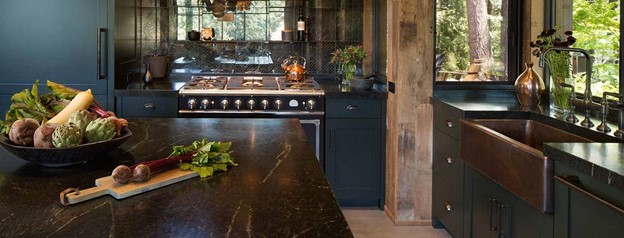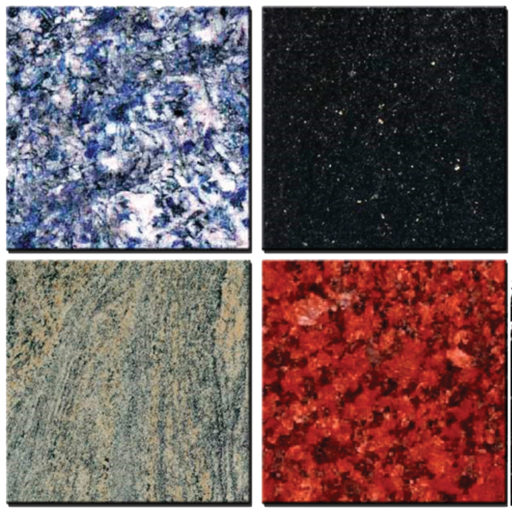Mother Nature never ceases to amaze! From precious gemstones to the grandeur of granite, she has come up with a natural stone possessing both beauty and unique characteristics found in no other refined stone in the world: Soapstone!
Being a metamorphic stone, Soapstone (also known as Steatite) contains varying amounts of mostly talc along with mica, chlorite, quartz and other minerals. It varies in softness depending on the amount of talc present, which makes it vulnerable to scratching. But, conversely, it is extremely dense to the degree of making it completely non-porous, creating a stone that is inert to acids, stains and water. It is also highly heat-resistant, adding to a myriad list of commercial and residential uses. Because of these natural qualities, Soapstone does not have to be sealed! All of this adds up to a versatile, easy-to-maintain beautiful natural stone.
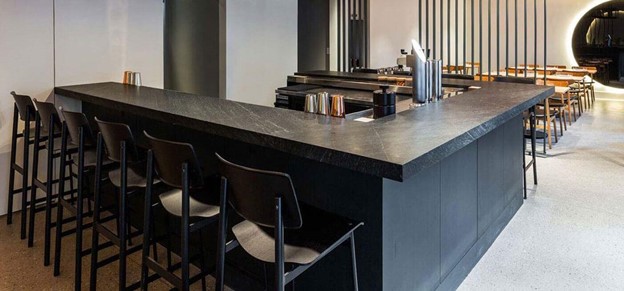
Where is Soapstone Quarried?
The majority of architectural-grade soapstone available here is quarried in Brazil, very far from the Amazon Rainforest in the state of Minas Gerais. *Fact: There are less than ten (10) active soapstone quarries n Brazil and less than two (2) in the U.S. In Carrara, Italy alone, there are currently eighty (80) active marble quarries!

Where Can You Use It?
Soapstone is so worry-free, its applications are numerous. In the kitchen, consider it for countertops, sinks and tile. In the bath, use it for sinks, tubs and tile. In the living areas of your home, it is ideal for fireplaces and woodstoves. Commercial applications are endless.
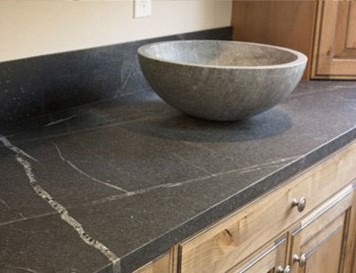
In The Kitchen
Soapstone will make life in your kitchen easy, reliable and hassle-free!
- From oven or stovetop, you can place your hot pots and pans directly on the counter.
- Spills? Who cares! Vinegar, cleaning chemicals, wine, and acidic or corrosive substances will not damage your counters.
- Water will wipe up with ease.
- No special cleaners or sealing required!
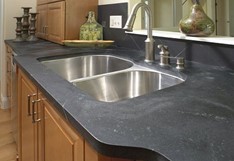
Let’s Talk Hardness!
As previously mentioned, the hardness of soapstone is based on the percentage of talc present. Architectural soapstone normally has a talc content between 15% to 50%. The less talc, the harder the stone. The harder the stone, the less scratching occurs. Scratching will happen with normal use. However, any marks can be removed with light sanding without the use of special tools. We compare this beautiful stone with a well-worn cowhide leather chair. Every crease, worn spot and stain tells the story of a well-loved, much-used piece of furniture. So goes soapstone. A biography of its existence will be told with every day’s use.
Natural Color vs. Treated Color
An untreated soapstone will come in varying shades of grey or soft blue. Choosing not to treat the stone will result in oil and other darker spots on the surface. You can choose to ignore the discoloration or clean it with a common household cleaner. Just remember, anything that you get on the soapstone surface will not penetrate the stone. It just becomes a worn area on the surface.
A treated soapstone using mineral oil will give your counters a deep, dark black or almost-black material. The shades of beige or green veining become prominent along with any quartz or other visible minerals within the stone. Mineral oil will help in the aging process with multiple treatments. Again, being completely non-porous, the stone will just fade, causing a beautiful patina to appear over time.

EleMar’s Soapstone Inventory
With the resurgence of Soapstone on the current market, we like to offer our customers with a variety of colors and geological content. All of our current inventory of material is all between 2-3 on the Mohs Scale of Hardness. Come see slabs of the following:
- Spider Soapstone from Brazil: Gorgeous heavy green veining covering a soft grey background. A customer favorite for its “showy” patterns. Fabricators like cutting this for its hardness.
- Brazilian Black Soapstone: Large veins of deep ivory on a dark grey background. Another customer favorite for its classic soapstone look.
- Blue Silk Soapstone: A soft blue hue with varying inclusions of quartz and other minerals. Veining is not a prominent characteristic of this stone.
- Barroca Soapstone: From the Baroque-inspired quarry in Brazil, this is a traditional light grey soapstone with occasional white veining.
EleMar is dedicated to bringing this remarkable and unique natural stone to you from the sustainable quarries of Brazil. We conveniently provide spray bottles of water for testing the slabs for color change, provide a larger selection than other suppliers and educate you to the many uncommon properties of this incredibly beautiful product. Come see us today!
